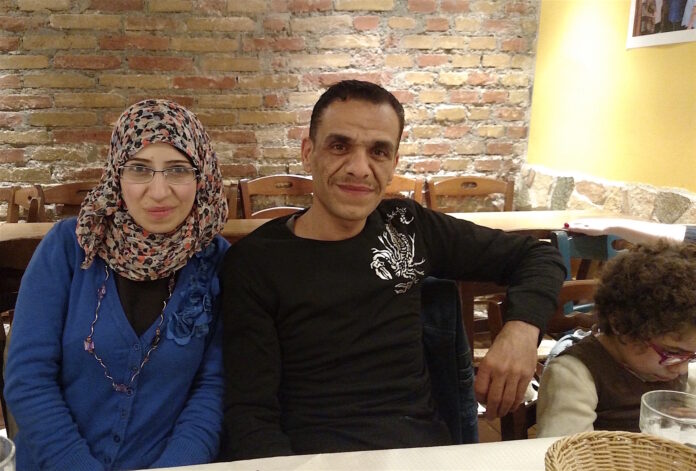They briefly considered the more dangerous Mediterranean crossing. But reports of the many deaths on the sea kept them away. Then their luck improved: a humanitarian initiative run by Italian religious communities helped them leave Jordan for Italy – and in 2015 the Al-Hourani family arrived safely in Rome.
Jasmine al-Hourani, her husband Suliman, their young son Hussein and daughter Falak were among the first Syrian refugees brought to Italy via a “humanitarian corridor,” through which Italy’s St. Egidio lay Catholic community, St. Mark’s Anglican Church in Florence and other Italian organizations have helped about 1,000 Middle Eastern and African refugee families resettle in Italy.
The corridor claims to be the first program of its kind in Europe, in which St. Egidio, the Federation of Evangelical Churches, and the Waldensian and Methodist churches are collaborating, with the permission of the Italian government. They have aided people in “vulnerable conditions” from Syria, Eritrea, Somalia, Sudan and other Sub-Saharan and Middle Eastern countries fleeing from imminent danger.
It dawned on the al-Houranis, who are among some four million Syrians who have emigrated to Europe since the bloody Syrian civil war began in 2011, that it might be many years before they could return home.
“We cannot go back to Syria; the Assad regime destroyed my family’s house,” said Jasmine al Hourani, during a dinner interview with her husband and two children in Rome.
Jasmine al-Hourani has a brother living in Germany who also arrived via a humanitarian effort, but most of her and her husband’s family still faces an uncertain future in Syria.
“We miss our family in Syria,” she said.
The Al-Houranis are originally from Homs, one of the largest and most devastated cities in the Syrian conflict, which by mid 2017 had claimed some half a million lives.
By the spring of 2017, the family had been in Italy for a little over a year. They live in a new apartment of their own about half an hour from the center, a home funded by the St. Egidio organization.
Although they now call Italy home, they were on the move for years, as they traversed the Middle East in search of care for their daughter’s rare form of eye cancer, retinoblastoma, which affects the retina. Falak, who goes by the nickname “Fifi,” had one eye removed at the American hospital in Beirut before the war started, and now has a prosthetic eye.
Falak continues to undergo chemotherapy about once every three months, and the cancer appears to have receded significantly. She is being treated at the St. Egidio-run Bambino Gesu hospital in Rome. The family had been traveling regularly from Homs to Jordan, for Falak’s treatment. But during the second year of these travels, the family realized it would have to be a one-way trip, as the border to Syria was closed to regular travel. And then they learned that their home had been destroyed.
Jasmine is focused on the future of her family. She said they were enjoying life in Italy, and were grateful for all of the assistance they’d received.
“I prefer Italy, I like the people and the nature,” Jasmine said. “They are good people in Italy.”
Jasmine, who had studied at university for three years, is the best English speaker. Nowadays, she’s taking courses in Italian, and cooking. The children are enrolled in school, and are learning Italian.
The St. Egidio refugees are visited by many people, including celebrities like Richard Gere, who visited in 2017.
Jasmine had her picture taken with the actor, she said; the family also met the pope.
Falak and Hussein skillfully spin all sides of the Mediterranean in their speech, alternating between Italian and Arabic. Jasmine Al-Hourani is generally pleased with her new Italian neighbors, who have been only helpful to them. Another feature of Italian society Jasmine likes is the better status of women.
“It is a more egalitarian society in Italy, and we like it; women are treated more equally,” she said.
The al Hourani family and other recipients of humanitarian aid can thank people like Maria Makepeace, a reader and painter-in-residence at St. Mark’s Anglican church in Florence. St. Mark’s donates food for the refugees St. Egidio hosts.

Makepeace, the daughter of English and Italian parents, has lived in Florence since 1997. After shuttling back and forth between England and Italy to study, she settled in Italy in 2015.
She likes to combine humanitarian work with her artistic abilities, and has established a “Dignity through Art” project, meant to enfranchise the homeless, street people, migrants and refugees. The portraits were exhibited at the Museo dell`Opera del Duomo in the center of Florence in 2016, where people from 17 different countries were represented. Makepeace hopes to stage the exhibit again in 2018.
Her inspiration came from the sheer number of artists and students in Florence, combined with the influx of refugees into Europe. Florence’s artistic history, and the character of these distinct groups, were a natural canvas for an artistic initiative.
“The idea was for the art students to get to know someone in need, ask them to sit for a portrait and paint them, getting to know their stories as the portrait evolved,” Makepeace said.
This artful spin on humanitarian aid not only helped refugees tell their stories, but helped the students and viewers better understand them as fellow human beings, rather than products of their status.
“I felt that people need to relate to those in need at a humanitarian rather than a merely material level,” Makepeace said.
Art may be a universal language, but conversation could still be difficult.
“The main difficulty that we encountered was the language barrier between English speakers and Italian speakers, although altogether 17 different nationalities were involved,” Makepeace said.
She also understands the difficulties that refugees and Italian citizens alike face in an unsteady political and economic climate.
“Sadly, while the Italian recession continues, it is difficult for anyone to find work here,” she said.
Though the socio-political fault lines are palpable, refugees and citizens can be drawn together by tragedy, such as by refugees’ volunteer efforts during recent earthquakes in Italy.
“From the experience of Amatrice and other earthquake-hit places, it is obvious that many of the refugees are willing to help out, even without payment,” Makepeace said, “in order to be given something good to do, which is useful, helpful to others.”


